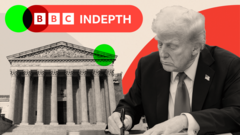In lower Manhattan, on a warm afternoon in late May 2024, the jury deliberating over Donald Trump’s hush money case had the country on edge. As I rushed to report the unfolding drama live for BBC, an unexpected verdict emerged: guilty on all 34 counts, marking the first time a former president faced such consequences in U.S. history. My analysis included an exploration of Trump's extensive legal challenges—four criminal cases and various civil actions—threatening to upend his political and commercial aspirations.
Fast forward about a year, and the narrative has shifted dramatically. A series of notable Supreme Court rulings has fortified Trump, affording him considerable immunity from prosecution. One ruling allowed him to pursue his ambitions despite efforts to contest the 2020 election results, while another curtailed lower court authority to thwart his agenda. Following a major reshaping of the court with a consolidated conservative majority, the administration now targets federal district judges who previously restrained executive actions.
Judges, both active and retired, express concern about an unprecedented scale of attack on the judiciary, with some former judges labeling it the “gravest assault on democracy.” Trump has disparaged judges with colorful language and called for the impeachment of those who dissent. Hostility towards judges has increased, leading to over 400 threats against nearly 300 judges by mid-June, many fueled by inflammatory rhetoric from the administration.
This hostility is compounded by unique challenges posed to judges, including threats and sinister tactics such as fake pizza deliveries linked to tragic events, raising alarms about the safety of the judiciary and the climate of intimidation. Various officials within Trump’s circle have echoed notions of judicial overreach, attempting to paint the judiciary as obstructive to the will of the people, a characterization that has drawn criticism from legal scholars.
In Trump’s push for rapid governance, the issuance of numerous executive orders has replaced traditional legislation, prompting nationwide injunctions and judicial pushback. Critics claim this signals a fundamental misunderstanding of constitutional law and expresses growing fears about the erosion of separate powers between branches of government.
Furthermore, with Trump reportedly delaying compliance with court decisions and the administration appearing to challenge judicial authority directly, observers worry about a systemic transformation that could redefine governance in America. As the judiciary confronts these challenges, the balance of power remains precarious, with significant implications for future presidencies. This ongoing battle raises questions about the resilience of democratic institutions and the potential long-term consequences of the current trajectory in American politics.
Fast forward about a year, and the narrative has shifted dramatically. A series of notable Supreme Court rulings has fortified Trump, affording him considerable immunity from prosecution. One ruling allowed him to pursue his ambitions despite efforts to contest the 2020 election results, while another curtailed lower court authority to thwart his agenda. Following a major reshaping of the court with a consolidated conservative majority, the administration now targets federal district judges who previously restrained executive actions.
Judges, both active and retired, express concern about an unprecedented scale of attack on the judiciary, with some former judges labeling it the “gravest assault on democracy.” Trump has disparaged judges with colorful language and called for the impeachment of those who dissent. Hostility towards judges has increased, leading to over 400 threats against nearly 300 judges by mid-June, many fueled by inflammatory rhetoric from the administration.
This hostility is compounded by unique challenges posed to judges, including threats and sinister tactics such as fake pizza deliveries linked to tragic events, raising alarms about the safety of the judiciary and the climate of intimidation. Various officials within Trump’s circle have echoed notions of judicial overreach, attempting to paint the judiciary as obstructive to the will of the people, a characterization that has drawn criticism from legal scholars.
In Trump’s push for rapid governance, the issuance of numerous executive orders has replaced traditional legislation, prompting nationwide injunctions and judicial pushback. Critics claim this signals a fundamental misunderstanding of constitutional law and expresses growing fears about the erosion of separate powers between branches of government.
Furthermore, with Trump reportedly delaying compliance with court decisions and the administration appearing to challenge judicial authority directly, observers worry about a systemic transformation that could redefine governance in America. As the judiciary confronts these challenges, the balance of power remains precarious, with significant implications for future presidencies. This ongoing battle raises questions about the resilience of democratic institutions and the potential long-term consequences of the current trajectory in American politics.




















